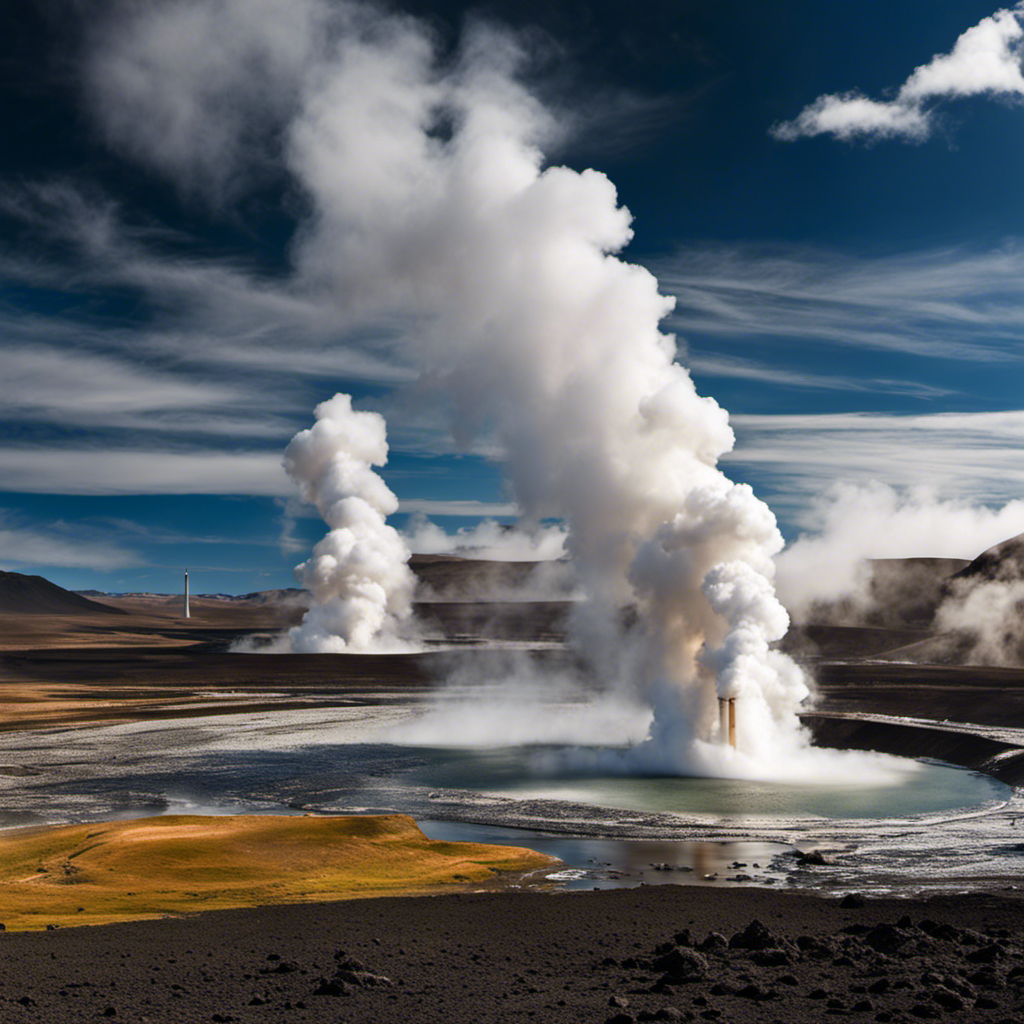Solar
Which Two Processes Involve The Flow Of Solar Energy Through The Earth System

Hello!
Ever wondered how solar energy flows through the Earth system? Well, I’ve got all the juicy details for you.
In this article, we’ll explore the two processes that involve the flow of solar energy through our planet. Brace yourself for some mind-blowing facts about the role of solar radiation, the greenhouse effect, and the impact of solar energy on climate patterns.
Get ready to dive into the fascinating world of solar energy and its influence on our Earth system. Let’s get started!
Key Takeaways
- Absorption of solar energy by the atmosphere helps warm it and regulate Earth’s temperature.
- Reflection, also known as albedo, affects the amount of solar energy reaching the surface.
- Surfaces with high albedo, like ice and snow, reflect more sunlight back into space.
- Surfaces with low albedo, like forests or asphalt, absorb more sunlight, leading to warming.
The Role of Solar Radiation in Earth’s Energy Balance
You need to understand the role of solar radiation in Earth’s energy balance. Solar radiation is the energy that is emitted by the Sun in the form of electromagnetic waves. It plays a crucial role in driving various processes on Earth.
When solar radiation reaches Earth’s atmosphere, it can have different effects. Some of it is absorbed by the atmosphere, while some is reflected back into space. The remaining solar radiation reaches the Earth’s surface, where it is either absorbed by the land, oceans, and vegetation or reflected back into the atmosphere.
This process of solar energy transfer is essential for maintaining the Earth’s temperature and climate. Understanding the effects of solar radiation and its transfer is vital for studying the Earth’s energy balance.
This knowledge sets the stage for exploring the absorption and reflection of solar energy by the Earth’s atmosphere.
Absorption and Reflection of Solar Energy by Earth’s Atmosphere
The atmosphere plays a crucial role in the absorption of solar energy. It contains various gases and particles that can absorb and scatter incoming solar radiation. This absorption process helps to warm the atmosphere and regulate Earth’s temperature.
Additionally, the impact of reflection is important in the distribution of solar energy. When sunlight hits the Earth’s surface, some of it is reflected back into space, which affects the amount of solar energy that reaches the surface and is available for absorption by the atmosphere.
Understanding these processes is essential for studying the distribution of solar energy in the Earth system.
Atmosphere’s Role in Absorption
One of the processes that involves the flow of solar energy through the earth system is how the atmosphere absorbs a significant amount of solar radiation. This atmospheric absorption plays a crucial role in regulating the amount of solar energy that reaches the Earth’s surface.
The atmosphere absorbs different wavelengths of solar radiation to varying degrees, with certain gases, such as carbon dioxide and water vapor, being particularly effective at absorbing infrared radiation. This absorption process helps to warm the atmosphere and maintain Earth’s temperatures within a habitable range.
Additionally, the atmosphere absorbs a portion of the incoming ultraviolet radiation, which is important for protecting living organisms from harmful UV rays.
Impact of Reflection
When sunlight strikes a surface, it bounces back, creating reflection. This reflection plays a crucial role in the Earth’s energy balance and has a significant impact on global warming.
The effect of reflection, also known as albedo, is the measure of how much light is reflected by a surface. Surfaces with high albedo, like ice and snow, reflect more sunlight back into space, resulting in a cooling effect on the planet.
On the other hand, surfaces with low albedo, such as dark forests or asphalt, absorb more sunlight, leading to warming. Understanding the impact of reflection and albedo is essential for studying climate change and developing strategies to mitigate global warming.
Transitioning to the next section, solar energy distribution is another important process in the flow of solar energy through the Earth system.
Solar Energy Distribution
To understand how solar energy is distributed, you need to consider factors such as the angle of incidence, the Earth’s rotation, and the atmosphere’s composition.
The angle of incidence refers to the angle at which sunlight hits the Earth’s surface. This angle changes throughout the day and affects the amount of energy received.
The Earth’s rotation also plays a role in solar energy distribution. As the Earth rotates, different parts of the planet receive varying amounts of sunlight.
Additionally, the composition of the atmosphere affects the transmission of solar energy. Certain gases in the atmosphere, such as greenhouse gases, can trap solar energy and contribute to the warming of the Earth’s surface.
Overall, understanding these factors is crucial in comprehending how solar energy is distributed and transmitted on our planet.
The Greenhouse Effect and Solar Energy
When it comes to understanding climate change, it’s crucial to examine the energy balance in the atmosphere. This balance refers to the equilibrium between the incoming solar radiation and the outgoing infrared radiation from Earth.
Greenhouse gases play a significant role in this process by trapping some of the outgoing radiation, thus warming the planet. This phenomenon, known as the greenhouse effect, has a direct impact on our climate and contributes to global warming.
Energy Balance in Atmosphere
You can understand the energy balance in the atmosphere by considering the flow of solar energy through the earth system. This balance is crucial for maintaining Earth’s temperature and climate.
The energy balance in the atmosphere is maintained through two main processes:
-
Radiation distribution: Solar radiation enters the atmosphere and is either absorbed or reflected back into space. This distribution determines the amount of energy that reaches the Earth’s surface.
-
Heat transfer: Once solar radiation reaches the Earth’s surface, it is absorbed and heats up the surface. This heat is then transferred to the atmosphere through conduction, convection, and evaporation.
Understanding the energy balance in the atmosphere is essential for predicting and studying climate change. By analyzing the distribution and transfer of solar energy, scientists can gain insights into the factors that influence Earth’s temperature and climate patterns.
Greenhouse Gases Role
Understanding the role of greenhouse gases is crucial in comprehending how they contribute to the Earth’s temperature and climate patterns.
Greenhouse gases, such as carbon dioxide, methane, and nitrous oxide, trap heat in the atmosphere, leading to the greenhouse effect. This effect is essential for maintaining a habitable climate on Earth, as it helps to regulate the planet’s temperature.
However, human activities, such as burning fossil fuels and deforestation, have significantly increased the concentration of greenhouse gases in the atmosphere. This enhanced greenhouse effect has resulted in global warming, causing a range of impacts, including rising sea levels, extreme weather events, and changes in precipitation patterns.
These effects have far-reaching consequences for the Earth’s climate system and the ecosystems that depend on it.
In the subsequent section, we will explore the specific impacts of greenhouse gases on climate.
Impact on Climate
The increased concentration of greenhouse gases is causing significant impacts on the Earth’s climate, including rising sea levels and extreme weather events. These effects are a result of climate change, which is primarily driven by global warming caused by human activities.
The consequences of climate change are far-reaching and can be seen across the globe. Some of the key impacts include:
-
Rising sea levels:
-
Increased melting of polar ice caps and glaciers contribute to the rise in sea levels.
-
Coastal areas are at risk of flooding and erosion, putting communities and ecosystems in danger.
-
Extreme weather events:
-
Higher temperatures lead to more frequent and intense heatwaves, wildfires, and droughts.
-
Increased precipitation can cause more frequent and severe storms, hurricanes, and floods.
These impacts highlight the urgent need for global action to mitigate greenhouse gas emissions and adapt to the changing climate.
Solar Energy and Earth’s Surface Temperature
Solar energy from the sun directly affects the surface temperature of the Earth. The energy radiated by the sun warms the Earth’s surface, leading to various climate phenomena.
One of the most significant impacts is the role of solar energy in global warming. As sunlight reaches the Earth’s surface, it is absorbed by land, oceans, and vegetation, causing them to heat up. This process contributes to the greenhouse effect, where certain gases in the atmosphere trap heat and raise the overall temperature of the planet.
However, solar energy also plays a crucial role in renewable energy sources. By harnessing the sun’s power through technologies like solar panels and solar thermal systems, we can generate clean and sustainable electricity, reducing our reliance on fossil fuels and mitigating the harmful effects of global warming.
Solar Energy and the Water Cycle
You can see how solar energy impacts the water cycle by observing how sunlight evaporates water from Earth’s surface, condenses it into clouds, and eventually causes precipitation.
Solar energy plays a crucial role in both the evaporation and precipitation processes of the water cycle. Sunlight heats the Earth’s surface, causing water to evaporate. The energy from the sun provides the necessary heat for water molecules to break free from the liquid and become water vapor.
As the water vapor rises and cools, it condenses into clouds. The sun’s energy is then used to power the water cycle, as it drives the movement and transformation of water through the atmosphere, resulting in precipitation.
Solar energy is the driving force behind these two essential processes in the water cycle, ensuring the continuous movement and distribution of water on Earth.
Solar Energy and Climate Patterns
In the previous subtopic, we discussed how solar energy plays a crucial role in the water cycle.
Now, let’s explore how solar energy influences climate patterns through its interaction with ocean currents and atmospheric circulation.
Solar energy drives the formation of ocean currents by heating the surface of the ocean unevenly. This causes warm water to flow towards colder regions, creating a complex network of currents that distribute heat around the globe.
These currents, in turn, influence regional climates by transporting warm or cold water to different areas.
Additionally, solar energy drives atmospheric circulation by heating the air at the equator, causing it to rise and flow towards the poles. This creates global wind patterns that impact weather systems and climate zones.
Therefore, solar energy is a key driver of climate patterns through its influence on ocean currents and atmospheric circulation.
Solar Energy and Photosynthesis
When sunlight reaches plants, it triggers a process that converts carbon dioxide and water into glucose and oxygen. This process is known as photosynthesis. It is the primary way in which solar energy is converted into chemical energy by plants.
The photosynthesis process can be summarized as follows:
- Sunlight is absorbed by chlorophyll in plant cells.
- The energy from sunlight is used to split water molecules into hydrogen and oxygen.
- Hydrogen is combined with carbon dioxide to produce glucose.
- Oxygen is released as a byproduct.
Through this process, plants are able to capture solar energy and convert it into glucose, which is used for growth and energy storage. Oxygen, on the other hand, is released back into the atmosphere, supporting life on Earth.
The photosynthesis process plays a crucial role in the Earth system as it not only provides energy for plants but also contributes to the oxygen production and carbon dioxide absorption. This interconnectedness between solar energy and the photosynthesis process highlights the importance of understanding and protecting our natural ecosystems.
Solar Energy and Human Impact on the Earth System
By understanding the impact of human activities on the Earth system, you can make informed choices to reduce your carbon footprint and promote sustainable energy solutions. Solar energy is a key component of renewable resources and plays a crucial role in environmental sustainability. Harnessing solar power for electricity generation is a clean and efficient way to meet our energy needs without depleting finite resources or contributing to greenhouse gas emissions. Solar panels, which convert sunlight into electricity, are becoming increasingly affordable and accessible, making it easier for individuals and businesses to adopt solar energy solutions. Additionally, investing in solar energy not only helps combat climate change but also creates jobs and stimulates economic growth. By embracing solar energy and renewable resources, we can contribute to a more sustainable and greener future.
| Advantages of Solar Energy | Disadvantages of Solar Energy | Examples of Solar Energy Applications |
|---|---|---|
| Renewable and abundant | High initial costs | Residential and commercial solar panels |
| No greenhouse gas emissions | Intermittent availability | Solar-powered street lights |
| Low maintenance | Dependent on weather conditions | Solar-powered water heaters |
| Reduces reliance on fossil fuels | Requires sufficient space for installation | Solar-powered vehicles |
| Long lifespan | Limited energy storage options | Solar-powered calculators and electronic devices |
Frequently Asked Questions
How Does Solar Energy Impact the Formation of Clouds and Precipitation?
Solar energy plays a crucial role in the formation of clouds and precipitation. As sunlight reaches the Earth’s surface, it warms the air and causes it to rise. This process, known as convection, creates upward air currents that carry moisture and water vapor higher into the atmosphere.
As this moist air cools and condenses, clouds form. Eventually, this condensation leads to the formation of precipitation, such as rain or snow. Thus, solar energy drives the entire cycle of cloud formation and precipitation.
What Is the Role of Solar Energy in the Melting of Glaciers and Polar Ice Caps?
Solar energy plays a crucial role in global warming and the melting of glaciers and polar ice caps. It contributes to the overall rise in temperatures, which leads to the melting of ice and snow.
This increased melting contributes to the rise in sea levels, posing a significant threat to coastal communities worldwide. The impact of solar energy on sea level rise is a direct consequence of its role in the warming of the Earth’s atmosphere.
How Does Solar Energy Affect the Distribution of Heat in the Oceans?
Solar energy plays a crucial role in the distribution of heat in the oceans. It influences the formation of ocean currents, which help transport heat around the globe.
Additionally, solar energy is vital for the process of photosynthesis in plants, promoting their growth and providing food and oxygen for marine life.
These two processes, driven by solar energy, contribute to the complex flow of energy through the Earth system, shaping our planet’s climate and ecosystems.
Can Solar Energy Influence the Movement of Ocean Currents?
Solar energy plays a significant role in the movement of ocean currents. The heat from the sun warms the ocean surface, causing temperature differences that drive the circulation of water.
As the water near the equator becomes warmer, it expands and rises, creating a low-pressure area. This leads to the formation of winds, known as atmospheric circulation.
These winds, in turn, cause the movement of ocean currents, influencing the global climate system.
How Does Solar Energy Impact the Growth and Development of Plants and Ecosystems?
Solar energy plays a crucial role in the growth and development of plants and ecosystems. It directly impacts photosynthesis, the process by which plants convert sunlight into energy. Solar energy provides the necessary light and heat for plants to carry out this vital process.
Additionally, solar energy is essential for maintaining biodiversity within ecosystems. It supports the growth of different plant species, which in turn provides habitat and food sources for a wide range of organisms.
Conclusion
In conclusion, solar energy plays a crucial role in various processes within the Earth system.
One interesting statistic is that the amount of solar energy reaching the Earth’s surface in one hour is enough to power the entire world for a year. This visual representation highlights the immense potential of solar energy and emphasizes the need to harness and utilize it effectively.
By understanding the flow of solar energy through the Earth system, we can better comprehend its impact on climate patterns, the water cycle, photosynthesis, and human activities.
Solar
Is Solar Energy Renewable Or Nonrenewable And Why

As I explore the question of whether solar energy is renewable or nonrenewable, I am intrigued by the potential consequences of our energy decisions.
Solar energy, in its essence, holds the promise of harnessing the power of the sun to create a sustainable future. Yet, as I explore the intricacies and factors that determine its renewability, I am compelled to uncover the truth.
Join me on this journey as we examine the advantages, environmental impacts, and the role of sunlight in solar energy to ultimately answer the question: Is solar energy truly renewable?
Key Takeaways
- Solar energy is a form of renewable energy derived from sources like sunlight.
- Transitioning to solar energy reduces dependence on non-renewable sources and contributes to a sustainable future.
- Sunlight availability and solar panel efficiency are crucial factors affecting the renewability of solar energy.
- Proper recycling of solar panels helps preserve the environment and supports a circular economy.
The Definition of Renewable Energy
Renewable energy is any form of energy that can be replenished naturally and is considered to be sustainable in the long term. It is derived from renewable energy sources such as sunlight, wind, water, and geothermal heat.
These sources are abundant and readily available, making them a viable alternative to fossil fuels. The use of renewable energy sources has gained significant attention due to the sustainability challenges posed by non-renewable energy sources.
Fossil fuels, for instance, are finite resources that contribute to climate change and air pollution. By transitioning to renewable energy, we can reduce our dependence on non-renewable sources and mitigate the environmental impacts associated with them.
This shift towards renewable energy is crucial for a sustainable future and a cleaner, healthier planet.
Advantages of Solar Energy
You’ll benefit from the advantages of harnessing the power of the sun. Solar energy offers numerous benefits that make it a sustainable choice for our energy needs.
Firstly, solar energy is renewable, meaning it will never run out. As long as the sun continues to shine, we can harness its power. This makes solar energy a reliable and long-lasting source of energy.
Additionally, solar energy is clean and does not produce harmful emissions like fossil fuels do. This contributes to a healthier environment and reduces the impact of climate change.
Furthermore, solar energy is abundant and widely available, making it accessible to communities around the world.
These advantages make solar energy a key player in the transition to a more sustainable future.
Now, let’s explore the factors that determine solar energy’s renewability.
Factors That Determine Solar Energy’s Renewability
The availability of sunlight and the efficiency of solar panels are key factors in determining the viability of harnessing energy from the sun. Solar energy is a renewable source of energy because sunlight is abundant and will continue to be available for billions of years. However, the efficiency of solar panels plays a crucial role in the overall effectiveness of harnessing solar energy. Table 1 below outlines the factors that determine the renewability of solar energy.
| Factors | Description |
|---|---|
| Sunlight Availability | The amount of sunlight that reaches the Earth’s surface affects the potential for solar energy. |
| Solar Panel Efficiency | The ability of solar panels to convert sunlight into usable energy is essential for renewable energy. |
| Technological Advances | Advances in solar panel technology can improve efficiency and make solar energy more viable. |
| Environmental Impact | The environmental impact of solar energy, such as the production and disposal of solar panels, is important to consider in its renewability. |
The Role of Sunlight in Solar Energy
When discussing the role of sunlight in solar energy, it is essential to recognize that sunlight serves as the primary source of energy for solar power generation.
Through the energy conversion process, sunlight is converted into usable energy, making it a crucial component of solar energy systems.
Understanding how sunlight is harnessed and transformed into electricity is key to comprehending the effectiveness and sustainability of solar power as a renewable energy source.
Sunlight as Primary Source
Sunlight’s abundance makes it an ideal primary source for solar energy. Solar power plants harness this abundant energy and convert it into electricity through the use of solar panels. These panels contain photovoltaic cells that absorb sunlight and convert it into usable energy.
One of the challenges with solar energy is energy storage. During the day, when sunlight is abundant, excess energy can be stored in batteries for later use when the sun is not shining. This allows for a continuous supply of electricity even during cloudy days or at night.
Additionally, solar power plants can be connected to the grid, allowing excess energy to be fed back into the system. With advancements in energy storage technology, solar energy is becoming an increasingly reliable and sustainable source of power.
Energy Conversion Process
Converting sunlight into electricity is achieved through the use of photovoltaic cells in solar panels. These cells contain semiconductors that absorb photons from sunlight, causing electrons to be released and creating an electric current.
However, one challenge of solar energy is its intermittent nature. Energy storage methods are crucial for ensuring a continuous power supply, especially during cloudy or nighttime conditions. Current energy storage technologies include batteries, pumped hydro storage, and thermal energy storage. These methods allow excess energy to be captured and stored for use when sunlight is not available.
In addition to terrestrial applications, solar energy is also being explored for use in space. Solar panels on satellites and spacecraft capture sunlight to power onboard systems and recharge batteries, providing a sustainable and efficient source of energy in space exploration.
Environmental Impacts of Solar Energy
When it comes to the environmental impacts of solar energy, two key points that deserve attention are solar panel recycling and land and habitat preservation.
As solar panels reach the end of their lifecycle, proper recycling is crucial to ensure the recovery of valuable materials and the reduction of waste.
Additionally, the installation of solar farms requires land, and it is important to consider the potential impact on habitats and ecosystems.
Solar Panel Recycling
Did you know that recycling solar panels is an important step in reducing waste and preserving our environment? When it comes to solar panel disposal, recycling is the most sustainable option. Here are some environmental benefits of recycling solar panels:
-
Reduction of waste in landfills: By recycling solar panels, we can prevent them from ending up in landfills, where they can release harmful chemicals and contribute to pollution.
-
Conservation of resources: Solar panels contain valuable materials like silicon, glass, and metals. Recycling these materials reduces the need for mining and extraction, conserving natural resources.
-
Energy conservation: Recycling solar panels requires less energy compared to manufacturing new ones. This helps decrease greenhouse gas emissions and mitigates the environmental impact of solar panel production.
-
Circular economy: Recycling solar panels supports the concept of a circular economy, where materials are reused and recycled, reducing our reliance on raw materials and promoting sustainability.
Land and Habitat Preservation
To preserve land and habitats, you can support conservation efforts and reduce your impact on the environment.
Wildlife conservation and ecosystem preservation are crucial for maintaining the balance of our natural world. By protecting habitats, we ensure the survival of countless species and maintain the integrity of ecosystems.
One way to support wildlife conservation is by donating to organizations that focus on protecting endangered species and their habitats. Additionally, reducing our carbon footprint can have a positive impact on ecosystems.
Choosing sustainable practices, such as using renewable energy sources, reducing waste, and practicing responsible tourism, can help minimize our impact on the environment.
Conclusion: Is Solar Energy Truly Renewable?
In conclusion, solar energy is indeed renewable due to its ability to harness the power of the sun. It offers a promising solution to the challenges of renewability and long-term sustainability.
Here are four key points to consider:
-
Abundant Resource: The sun provides an unlimited supply of energy, making solar power a reliable and sustainable source for the future.
-
Low Environmental Impact: Unlike fossil fuels, solar energy production doesn’t release harmful greenhouse gases or contribute to air pollution, minimizing its impact on climate change.
-
Scalability: Solar energy systems can be installed on various scales, from residential rooftops to large solar farms, making it accessible and adaptable to different needs.
-
Technological Advancements: Continued research and development have led to significant improvements in solar panel efficiency and cost-effectiveness, making it a viable long-term solution.
These factors, along with ongoing advancements in solar technology, make solar energy a truly renewable and sustainable source of power.
Frequently Asked Questions
How Does Solar Energy Compare to Other Renewable Energy Sources in Terms of Efficiency and Cost-Effectiveness?
When comparing solar energy to other renewable sources, efficiency and cost-effectiveness are important factors to consider.
Solar energy is an efficient option as it harnesses sunlight, a resource that is abundantly available.
In terms of cost, solar energy has become more affordable over the years due to advancements in technology and economies of scale.
However, it is essential to analyze efficiency and cost comparisons specific to each renewable source to determine the most suitable option for a particular situation.
Are There Any Limitations or Drawbacks to Using Solar Energy as a Primary Source of Power?
When considering the limitations and drawbacks of using solar energy as a primary source of power, it is important to recognize that no energy source is without its challenges.
Solar energy has its own set of limitations, such as dependence on sunlight, intermittency, and high initial costs. Additionally, drawbacks include the need for large areas of land for installation and the production of potentially hazardous materials during the manufacturing process.
Despite these concerns, advancements in technology and decreasing costs make solar energy a promising renewable option for the future.
What Are the Main Challenges Faced in Harnessing Solar Energy on a Large Scale?
When considering the challenges in implementing solar energy on a large scale, one of the main obstacles is its economic viability. The initial cost of installing solar panels and infrastructure can be expensive, although the long-term benefits are often worth it.
Additionally, the intermittency of solar power can pose challenges in ensuring a consistent and reliable energy supply. However, advancements in technology and the increasing demand for renewable energy are driving efforts to overcome these challenges and make solar energy more accessible and efficient.
How Does the Availability of Sunlight Vary in Different Regions and How Does It Affect the Viability of Solar Energy?
The variability of sunlight across different regions plays a crucial role in determining the viability of solar energy. Some regions receive more sunlight throughout the year, making them more suitable for harnessing solar energy.
Other regions may have less consistent sunlight, which can affect the efficiency and reliability of solar power systems. Understanding the solar energy potential and considering the variability of sunlight is essential for effectively utilizing this renewable energy source.
What Technological Advancements Are Being Made to Improve the Efficiency and Storage Capabilities of Solar Energy Systems?
Improving efficiency and storage advancements are important areas of research in the field of solar energy. Scientists and engineers are constantly working on developing new technologies to make solar systems more efficient and capable of storing excess energy.
Conclusion
After conducting thorough research, it’s evident that solar energy is indeed a renewable source. Like a never-ending river flowing with energy, the sun provides an endless supply of sunlight, which is converted into usable power through solar panels.
This sustainable and clean energy source offers numerous advantages, such as reducing greenhouse gas emissions and creating jobs. While there are environmental considerations associated with solar energy, its positive impacts outweigh the negatives.
Therefore, it’s clear that solar energy holds the key to a brighter and more sustainable future.
Solar
Which Gases React With Solar Energy To Produce The Arura Borealis

Having a keen interest in stargazing, I have always been mesmerized by the enchanting beauty of the Northern Lights.
But have you ever wondered which gases are responsible for this mesmerizing display?
In this article, we will delve into the fascinating world of solar energy reactions and explore the role of nitrogen, oxygen, hydrogen, and other gases in the creation of the Aurora Borealis.
Prepare to unravel the secrets behind the intensity and color of this celestial phenomenon.
Key Takeaways
- Nitrogen molecules in the Earth’s upper atmosphere become excited when bombarded by high-energy particles from the Sun.
- Oxygen molecules in the upper atmosphere are excited by collision with energetic particles from the Sun.
- Nitrogen provides the primary source of illumination in the aurora borealis.
- Oxygen is responsible for the red and green colors observed in the aurora borealis.
Role of Nitrogen in the Formation of the Aurora Borealis
Nitrogen plays a crucial role in the formation of the aurora borealis. Under specific atmospheric conditions, nitrogen molecules in the Earth’s upper atmosphere become excited when bombarded by high-energy particles from the Sun. These excited nitrogen atoms then release the excess energy by emitting light, creating the mesmerizing colors of the aurora borealis.
The exact color of the aurora depends on the altitude at which the nitrogen molecules are excited, with blue and purple hues occurring at higher altitudes and green and red colors at lower altitudes. The role of nitrogen in the aurora borealis phenomenon is essential, as it provides the primary source of illumination in this celestial light show.
However, it is not the only gas involved, as the contribution of oxygen to the aurora borealis phenomenon is also significant.
Contribution of Oxygen to the Aurora Borealis Phenomenon
Oxygen contributes to the phenomenon of the Aurora Borealis by reacting with solar energy. As a major component of Earth’s atmosphere, oxygen plays a significant role in the formation of this captivating natural phenomenon. Here are some key points to consider regarding the contribution of oxygen to the Aurora Borealis:
-
Oxygen molecules in the upper atmosphere are excited by the collision with energetic particles from the Sun, such as solar wind.
-
This excitation causes the electrons in the oxygen atoms to jump to higher energy levels.
-
When the electrons return to their original energy levels, they emit photons of light, creating the colorful display of the Aurora Borealis.
-
The atmospheric composition is crucial for the formation of the Aurora Borealis.
-
Oxygen is responsible for the red and green colors observed in the Aurora Borealis.
-
The specific altitude at which the oxygen molecules are excited determines the color intensity and distribution of the Aurora Borealis.
Understanding the contribution of oxygen to the Aurora Borealis enhances our knowledge of Earth’s atmosphere and the interactions between the Sun and our planet.
The Influence of Hydrogen on the Creation of the Aurora Borealis
Did you know that hydrogen also plays a role in the creation of the Aurora Borealis? While oxygen is the main contributor to this phenomenon, hydrogen is present in the upper atmosphere and interacts with solar energy to produce the spectacular light display.
The influence of helium on the creation of the aurora borealis is significant as well. Helium, being a noble gas, remains stable and does not actively participate in the reaction.
On the other hand, the impact of carbon dioxide on the formation of the aurora borealis is minimal. Carbon dioxide molecules do not possess the necessary properties to effectively interact with solar energy.
However, there are other gases involved in the solar energy reaction for the aurora borealis, and their roles will be explored in the subsequent section.
Transitioning to the next section, let’s now delve into the other gases that contribute to this mesmerizing natural phenomenon.
Other Gases Involved in the Solar Energy Reaction for the Aurora Borealis
Transitioning to the other gases involved, let’s explore how they contribute to the mesmerizing natural phenomenon of the Aurora Borealis. The interaction between solar wind and Earth’s magnetic field is the key driving force behind this spectacular display. Here are some key points to understand their role:
- Nitrogen and oxygen are the primary gases involved in the production of the Aurora Borealis. Nitrogen molecules get excited by the energetic particles from the solar wind.
- Oxygen atoms, on the other hand, emit different colors depending on their energy levels.
The influence of atmospheric pressure on the Aurora Borealis is also significant. Higher pressure leads to a more intense display, as it compresses the gases and increases their collision rates. Additionally, variations in solar wind intensity and the strength of Earth’s magnetic field contribute to the variations in the color and intensity of the aurora borealis.
Understanding these factors is crucial in unraveling the mysteries of this captivating natural phenomenon.
Factors Affecting the Intensity and Color of the Aurora Borealis
The atmospheric pressure and solar wind intensity directly impact the intensity and color of the mesmerizing Aurora Borealis.
The speed and movement of this natural phenomenon are influenced by several factors. One crucial factor is the strength of the solar wind, which is a stream of charged particles emitted by the Sun. When the solar wind is weak, the aurora tends to be less active and may appear as a faint glow. On the other hand, when the solar wind is strong, the aurora becomes more vibrant and dynamic, with rapid movements and changes in shape.
Another factor that can affect the intensity of the aurora is solar flares. These explosive eruptions on the Sun’s surface release a tremendous amount of energy, which can enhance the brightness and vividness of the aurora.
Understanding these factors is essential for predicting and studying the behavior of the Aurora Borealis.
Frequently Asked Questions
How Long Does It Take for the Gases to React With Solar Energy and Produce the Aurora Borealis?
How quickly do the gases react with solar energy to produce the aurora borealis, and what factors can affect the reaction time?
The speed at which the gases react with solar energy to create the aurora borealis can vary. Factors such as the density of the gases, the intensity of the solar energy, and the composition of the atmosphere can all play a role in the reaction time. Understanding these factors is crucial in studying the formation of this mesmerizing natural phenomenon.
Can the Aurora Borealis Be Seen From Anywhere on Earth?
Ironically, the aurora borealis cannot be seen from anywhere on Earth. Long term visibility of this stunning natural phenomenon is limited to high-latitude regions, closer to the Earth’s magnetic poles.
The best time to view the aurora borealis is during the dark winter months, when the nights are longest. However, even in these regions, various factors such as weather conditions and solar activity can affect the visibility of the aurora borealis.
Are There Any Harmful Effects of the Gases Involved in the Creation of the Aurora Borealis?
Harmful effects and environmental impact are important considerations when examining the gases involved in the creation of the aurora borealis. It is crucial to understand the potential consequences of these gases on our planet.
How Do Variations in Solar Activity Affect the Formation of the Aurora Borealis?
Variations in solar activity play a crucial role in the formation of the aurora borealis. The impact of solar activity on the appearance of the aurora borealis is significant.
As the sun releases charged particles during periods of high solar activity, these particles interact with gases in the Earth’s atmosphere, such as oxygen and nitrogen. This interaction results in the beautiful display of lights known as the aurora borealis.
Understanding the relationship between solar activity and aurora borealis formation is essential for studying this natural phenomenon.
Are There Any Specific Locations on Earth Where the Aurora Borealis Is More Likely to Occur?
Specific locations on Earth where the aurora borealis is more likely to occur exhibit predictable patterns. These patterns are influenced by factors such as geomagnetic latitude, solar wind activity, and Earth’s magnetic field.
Regions closer to the magnetic poles, like the Arctic and Antarctic, experience a higher frequency of auroral displays. Additionally, areas with clear skies and minimal light pollution enhance the visibility of the phenomenon.
Understanding these location-based patterns helps researchers predict and study the aurora borealis more effectively.
Conclusion
In conclusion, the gases nitrogen, oxygen, and hydrogen play crucial roles in the formation of the mesmerizing Aurora Borealis. These gases react with solar energy to produce the vibrant colors and patterns that captivate our senses.
Additionally, other gases contribute to this enchanting phenomenon, although to a lesser extent. Factors such as solar activity and atmospheric conditions affect the intensity and color of the Aurora Borealis.
It is truly fascinating how these gases, like celestial alchemists, create such a breathtaking spectacle in the night sky.
Solar
Which Of These Is Not A Benefit Of Solar Energy

Picture a world where all residences and businesses are fueled by clean, renewable energy sources. Solar power has risen to the forefront in the push for a sustainable future. With its cost-effectiveness, positive impact on the environment, energy independence, job opportunities, reliability, grid resilience, and contribution to global climate change mitigation, solar energy presents a wide range of advantages.
However, not all benefits are created equal. In this article, I will explore which of these benefits may not be as advantageous as they seem.
Key Takeaways
- Solar energy reduces carbon emissions and mitigates climate change.
- Solar power significantly decreases carbon footprint.
- Solar energy emits no greenhouse gases during operation.
- Solar power reduces air pollution and promotes a clean energy transition.
Cost Savings
You can save money by using solar energy instead of traditional sources of power. Solar energy offers significant cost efficiency and can provide a great return on investment.
The initial cost of installing solar panels may seem high, but over time, the savings on electricity bills can be substantial. Solar power systems have a long lifespan, typically lasting 25 to 30 years, which means you can enjoy the benefits for many years. Additionally, solar panels require minimal maintenance, reducing any ongoing expenses.
The return on investment for solar energy is also impressive. Not only do you save money on electricity bills, but you can also take advantage of government incentives and tax credits, further enhancing the financial benefits of going solar.
Overall, choosing solar energy is a smart decision that can lead to long-term cost savings and a positive return on investment.
Environmental Impact
Renewable energy sources, such as solar and wind power, play a crucial role in reducing carbon emissions and mitigating the harmful effects of climate change. By harnessing the power of the sun or wind, we can generate electricity without relying on fossil fuels. Fossil fuels release large amounts of greenhouse gases into the atmosphere, contributing to global warming.
This shift towards renewable energy is not only environmentally responsible but also necessary for a sustainable future. As the demand for energy continues to grow, it is important to transition to renewable sources that are abundant and can be replenished. Investing in renewable energy infrastructure also creates jobs and stimulates economic growth. Additionally, renewable energy technologies have become more efficient and cost-effective in recent years, making them a viable alternative to traditional energy sources.
Renewable Energy Source
Solar energy is a sustainable option for generating electricity. When it comes to renewable energy integration, solar power plays a vital role in reducing our dependence on fossil fuels.
Solar panels, with their increasing efficiency, are becoming more affordable and accessible. The integration of solar energy into the power grid helps diversify our energy sources and reduces the strain on non-renewable resources.
The advancements in solar panel technology have significantly improved their efficiency, allowing for more electricity to be generated from a smaller area of panels. This increased efficiency means that solar energy can now be harnessed even in areas with less sunlight.
As we transition to a cleaner energy future, solar power provides a reliable and sustainable solution. By reducing our reliance on fossil fuels, solar energy contributes to the reduction of carbon emissions and helps combat climate change.
Reduces Carbon Emissions
By utilizing solar power, you can significantly decrease your carbon footprint and contribute to a cleaner environment. Solar energy is a renewable source that harnesses the power of the sun to generate electricity.
This clean and sustainable energy option reduces air pollution, as it emits no greenhouse gases during operation. By using solar power instead of traditional fossil fuel-based energy sources, we can promote a clean energy transition and reduce our dependence on non-renewable resources.
Solar panels convert sunlight into electricity, providing a viable and environmentally friendly alternative to conventional energy sources. With the increasing affordability and efficiency of solar technology, more people are embracing this renewable energy option, further contributing to the reduction of carbon emissions and the promotion of a cleaner and greener future.
Transitioning to solar power not only benefits the environment but also provides economic advantages and energy independence.
Energy Independence
Reduced electricity bills and environmental sustainability are two key benefits of adopting renewable energy sources, such as solar power.
By harnessing the sun’s energy, homeowners can significantly reduce their reliance on traditional electricity grids, resulting in lower monthly bills.
Furthermore, solar energy is a sustainable and clean alternative that helps reduce greenhouse gas emissions and promotes a healthier environment for future generations.
Reduced Electricity Bills
Did you know that you can save money on your electricity bills with solar energy? Installing solar panels on your property can result in significant cost savings over time. Here are a few reasons why solar energy can help reduce your electricity bills and increase your property value:
- Reduced energy consumption: Solar panels generate electricity from sunlight, reducing the amount of electricity you need to purchase from the grid.
- Lower maintenance costs: Solar panels require minimal maintenance, resulting in lower maintenance expenses compared to traditional energy sources.
- Long-term savings: Solar energy provides a long-term solution for generating electricity, allowing you to save money on your bills for years to come.
- Increased property value: Homes with solar panels are often more attractive to buyers, leading to increased property value.
- Financial incentives: Many governments and utility companies offer financial incentives such as tax credits and rebates for installing solar panels.
By reducing your electricity bills and increasing your property value, solar energy can provide both economic and environmental benefits.
Transitioning to the next section, let’s explore the environmental sustainability of solar energy.
Environmental Sustainability
Installing solar panels on your property can help preserve the environment by reducing your dependence on traditional energy sources. Solar energy is a clean and renewable source of power that produces electricity without emitting greenhouse gases.
By harnessing the power of the sun, we can significantly reduce our carbon footprint and contribute to the reduction of greenhouse gas emissions. Additionally, solar energy does not deplete natural resources like fossil fuels do. It is a sustainable solution that ensures the conservation of our precious resources for future generations.
Transitioning to solar energy not only benefits the environment but also creates new opportunities for job creation in the renewable energy sector.
Job Creation
One of the benefits of solar energy is that it creates jobs in the renewable energy sector. This not only helps in reducing unemployment rates but also contributes to economic growth. The job opportunities in the solar industry range from installation and maintenance to research and development.
Here are five reasons why job creation in the solar energy sector is beneficial:
-
Job Training: The solar industry provides opportunities for individuals to learn new skills and gain specialized training in renewable energy technologies.
-
Local Employment: Solar energy projects often require local labor, which helps stimulate the local economy and provides job opportunities for nearby communities.
-
Long-Term Careers: The solar industry offers stable and long-term career prospects, as the demand for solar energy continues to grow.
-
Diverse Workforce: Solar energy attracts individuals from various backgrounds, promoting diversity and inclusion in the workforce.
-
Innovation: The solar industry fosters innovation and encourages the development of new technologies, creating additional job opportunities in research and development.
Reliability
Transitioning from the previous subtopic of job creation, let’s now delve into the reliability of solar energy. While solar power offers numerous benefits, it also presents some challenges in terms of reliability. One of the main challenges is its dependence on sunlight, which can be affected by cloudy days, nighttime, and seasonal variations. This intermittency can cause fluctuations in power generation, impacting its reliability as a consistent energy source. To mitigate this, solar energy systems often incorporate energy storage solutions, such as batteries, to provide a continuous power supply.
Moreover, solar panels require regular maintenance to ensure optimal performance. Dust, dirt, and debris can accumulate on the panels, reducing their efficiency. Additionally, extreme weather conditions like hailstorms or heavy snowfall can damage the panels, requiring repairs or replacements. Therefore, regular maintenance and inspection are essential to address these reliability challenges and maximize the longevity of solar energy systems.
To provide a visual representation, here is a table showcasing some of the reliability challenges and maintenance requirements of solar energy:
| Reliability Challenges | Maintenance Requirements |
|---|---|
| Dependence on sunlight | Regular cleaning of panels |
| Intermittency | Repairs for weather damage |
| Periodic inspection |
Grid Resilience
To ensure the resilience of your grid, it’s important to have backup power sources in place in case of any disruptions. This is crucial for maintaining a reliable and stable energy supply, especially during unexpected events such as power outages. Here are some key considerations for grid resilience:
-
Proper grid infrastructure: Investing in a robust and well-maintained grid infrastructure helps minimize the risk of power outages. Upgrading transmission and distribution systems can enhance the grid’s ability to withstand disruptions.
-
Diverse energy sources: Incorporating a mix of renewable and non-renewable energy sources diversifies the grid’s power generation capabilities. This reduces dependency on a single energy source and increases overall resilience.
-
Microgrids: Implementing microgrids can provide localized power supply and enhance grid resilience by isolating specific areas during disruptions.
-
Energy storage systems: Deploying energy storage systems, such as batteries, allows for the storage of excess energy during periods of low demand. This stored energy can be utilized during power outages, ensuring a continuous power supply.
-
Smart grid technologies: Utilizing smart grid technologies enables real-time monitoring, control, and optimization of the grid. This improves overall grid resilience by identifying and resolving issues more efficiently.
Global Climate Change Mitigation
Investing in renewable energy sources is crucial for mitigating the effects of global climate change. As the world grapples with the urgent need to reduce greenhouse gas emissions, renewable energy technologies, such as solar power, have emerged as a viable solution.
Solar energy offers numerous benefits in terms of climate change adaptation and international cooperation. Climate change adaptation is essential to ensure that societies and ecosystems are resilient to the impacts of climate change. By investing in solar energy, countries can reduce their reliance on fossil fuels, which are major contributors to greenhouse gas emissions. Solar power provides a clean, sustainable, and abundant source of energy, minimizing the carbon footprint and helping to limit global warming.
Furthermore, solar energy offers opportunities for international cooperation. Countries can collaborate on research, development, and implementation of solar technologies, sharing knowledge, resources, and best practices. International agreements and partnerships can foster the exchange of expertise and promote the widespread adoption of solar energy, contributing to a global effort to combat climate change.
Frequently Asked Questions
How Does Solar Energy Affect the Overall Cost of Electricity?
Solar energy has a significant impact on the overall cost of electricity. By harnessing the power of the sun, solar energy reduces the dependence on traditional sources of electricity, which can be costly and environmentally damaging.
Additionally, solar energy has a positive effect on electricity prices by lowering them over time. The integration of solar energy into the grid infrastructure helps to enhance its efficiency and reliability.
Overall, solar energy plays a crucial role in reducing electricity costs and improving the resilience of the grid.
What Are the Specific Environmental Benefits of Solar Energy Compared to Other Renewable Sources?
Solar energy offers multiple environmental benefits compared to other renewable sources.
One interesting statistic is that the cost effectiveness of solar power has significantly improved due to technological advancements.
In terms of environmental benefits, solar energy reduces greenhouse gas emissions, helps combat climate change, and decreases reliance on fossil fuels.
Additionally, solar panels require minimal water for operation, making them an ideal choice in water-scarce areas.
These advantages make solar energy a sustainable and eco-friendly option for a greener future.
Can Solar Energy Completely Eliminate the Need for Traditional Energy Sources?
Solar energy has the potential to greatly reduce our reliance on traditional energy sources. While it may not be able to completely eliminate the need for them, it can certainly play a significant role in reducing our carbon footprint and dependence on fossil fuels.
The reliability of solar energy has improved over the years, making it a viable and sustainable option for generating electricity. However, it is important to note that solar energy alone may not be able to meet all of our energy needs at all times.
How Does Solar Energy Contribute to Job Creation in Local Communities?
Solar energy contributes significantly to job creation in local communities, leading to economic growth. By investing in solar power infrastructure, we create job opportunities in installation, maintenance, and manufacturing. This not only supports local economies but also reduces dependence on traditional energy sources.
The shift towards solar energy promotes a sustainable and clean energy future while stimulating economic development. The growth in the solar industry has the potential to create a multitude of well-paying jobs and drive local economies forward.
What Measures Are in Place to Ensure the Reliability and Efficiency of Solar Energy Systems?
Reliability measures and efficiency standards are crucial in ensuring the effectiveness of solar energy systems. Various safeguards are in place to guarantee their performance.
For instance, regular maintenance and inspections help identify and address any issues promptly. Additionally, strict quality control measures ensure that solar panels and other components meet the highest standards.
These measures not only enhance the reliability of solar energy systems but also optimize their efficiency, making them a reliable and cost-effective source of renewable energy.
Conclusion
In conclusion, solar energy offers numerous benefits, making it a clear choice for a sustainable future.
Not only does it provide cost savings by reducing electricity bills, but it also has a positive environmental impact by reducing greenhouse gas emissions.
Solar energy promotes energy independence and job creation, contributing to economic growth.
Additionally, it enhances grid resilience and mitigation of global climate change.
While some argue that solar energy is expensive to install, government incentives and decreasing costs make it an increasingly viable option for all.
-

 Sustainable Supply Chain Management3 months ago
Sustainable Supply Chain Management3 months agoManagEnergy Acquires GPST2030.org Domain to Strengthen Commitment to Sustainable Transport
-

 Wind Energy4 months ago
Wind Energy4 months agoHow Much Oil Does It Take To Lubricate A Wind Turbine
-

 Electric Motorbike2 months ago
Electric Motorbike2 months agoCalifornia Electric Motorcycle Laws: A Comprehensive Guide to Riding Safely
-

 Solar3 months ago
Solar3 months agoIn 2009, About What Percent Of U.S. Energy Consumption Was Supplied By Solar Energy
-

 Electricity Vehicle2 months ago
Electricity Vehicle2 months agoThe Future of Electric Vehicles: Trends and Innovations to Watch
-

 Wind Energy2 months ago
Wind Energy2 months agoRevolutionizing Highways: Wind Turbines Take the Road to Renewable Energy
-

 Wind Energy2 months ago
Wind Energy2 months agoEnvironmental Innovation Turned Deadly: Ocean Wind Turbines Pose Threat to Whales’ Survival
-

 Solar3 months ago
Solar3 months agoWhy Should We Use Solar Energy Instead Of Fossil Fuels



















